Matrox Triple Head2Go Digital Edition Review
Matrox Triple Head2Go Digital Edition
The ultimate digital three-way?
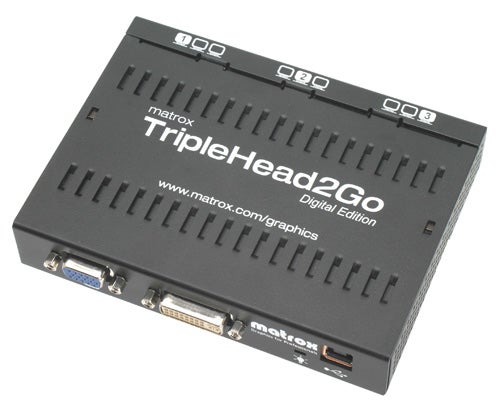
Verdict
Key Specifications
- Review Price: £223.25
It was over a year ago that I looked at Matrox’s TripleHead2Go – a fantastic little device that enabled you to run three screens off a single graphics output, with a maximum resolution of 3,840 x 1,024. Plug it into a notebook and you could have those three screens in addition to the notebook’s own – a four screen display, enough for even the most desktop real-estate hungry user. What it simply does it to present itself to Windows as a single very large display, which you can then divide up using the supplied software.

There was one major drawback however, and that was that the device was VGA only, which meant that all of your external displays would not be quite as crisp and sharp as they possibly could be. Just to be clear, the VGA output on a graphics card is analogue, while LCD displays are inherently digital, so with a VGA version the display has to turn the analogue input back into a digital signal, which makes for a slightly less sharp image. With the new Digital Edition though, the entire path remains digital, keeping the image clean, crisp and clear. However, there’s a VGA port on there too, should you need it.
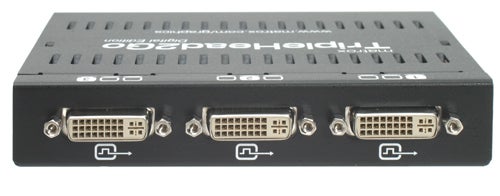
The Digital Edition is physically larger than the previous version, simply in order to accommodate the larger DVI connectors. Another difference is that it’s now powered by USB rather than an external power adaptor. This means that you don’t need a spare wall power socket, but does mean you use up one of your USB ports, which could be at even more of a premium, especially on a laptop. Overall, though, it’s a neater solution.
First off, you’ll need three LCD monitors, preferably with a resolution of 1,280 x 1,024, which means a 17in or 19in screen giving you 3,840 x 1,024. You could also use three 1,024 x 768 displays as 3,072 x 768 is also supported, though that’s not using it to its full potential.
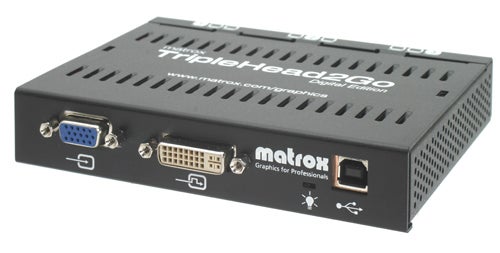
Hook up is straightforward and Matrox supplies a solid looking DVI cable complete with gold plated connector. If you really are going to take the triple screen plunge it makes sense to seek out screens with as thin a bezel as possible, as this will make for the best experience. NEC’s 90 series is ideal in this regard as it’s designed for traders who want to fit as many screens together on one desk as possible, but they’re pretty pricey. It would be sensible to hunt around.
Cleverly though, Matrox has introduced another improvement with the digital version and that’s with its software. Matrox supplies its PowerDesk SE software to help make the best use of your new expanse of space. A new option is Bezel Management, which essentially takes account of the fact that there are physical bezels in front of you. It actually creates space in the image to compensate for the presence of the bezels, which actually makes a big difference. By removing the parts of the image that the bezels occupy it reduces the width of the overall image, which means that you get black bars on the far left and right. If you have displays with larger bezels, you can manually increase the amount of pixels omitted, so the thinner they are the better. In regular Windows, you would want to turn off Bezel Management as you wouldn’t want those gaps in your desktop. PowerDesk is a good bit of software, though I think it could be better laid out.
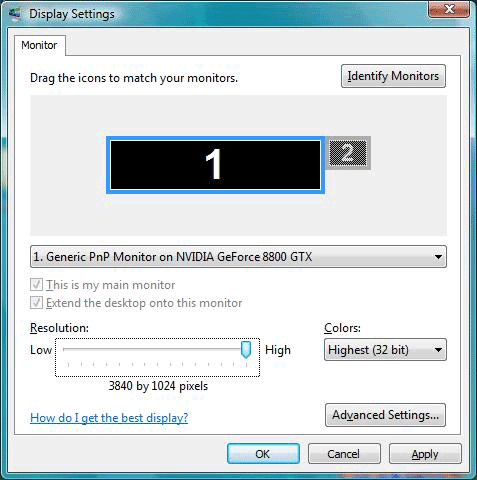
”’(centre)That’s um, pretty wide actually.(/centre)”’
As you can see from the picture below, taken in Elder Scrolls IV: Oblivion, the pillar on the pier in front of the ship is hidden ‘behind’ the bezel as it were. Turn off Bezel Management and from that position that same pillar would be split across the two screens. With it turned on in games, it actually makes for a more realistic experience. In fact, in driving games it’s near essential, as it means that the lines of the tracks aren’t broken up. What’s more, the presence of a bezel would actually mimic the A pillars that hold the windscreen in place in a car, making it even more realistic.
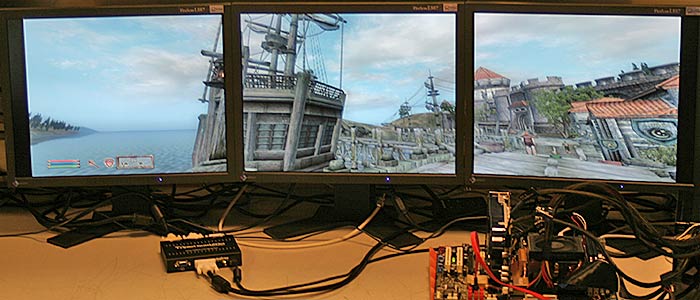
As well as Bezel Management, PowerDesk also includes settings for you to control how windows and dialogue boxes are handled. For example selecting maximise at the top right will maximise into the screen that the windows is in but you can get it to maximise across all three screens by holding control.
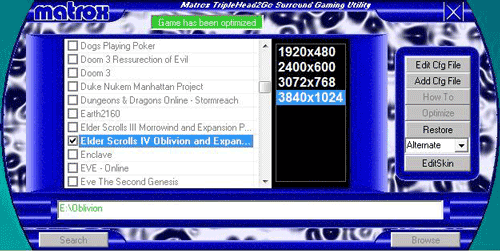
Matrox also supplies its Surround Gaming Utility (SGU), which automatically detects supported games and will optimise them with one click to work across three screens and will place a shortcut on the desktop. What it does is alter the ini file of the game to work at the superwide resolution, so you don’t have to go and do it manually. For some reason, there are a number of skins available for the SGU, and you can even customise it with your own fonts and images. I can’t really see the point in this but there you go.
A potential problem is that only supported games will work with the TripleHead2Go, which is listed on the web site. There’s a pretty comprehensive list out there, with a good number of recent games, but you can’t buy the TripleHead expecting it to work with every game that’s going to be released. If you did end up in a situation where your particular favourite title wasn’t supported then you could end up having to play on a regular 4:3 monitor, where you might have better spent your money on a single widescreen. It’s best to think of this then as a great solution for a particular title. For example, fans of Microsoft Flight Simulator are big fans of the triple head. It’s a title that doesn’t get updated every year, support is solid in the TripleHead and having the side screens really adds to the experience.
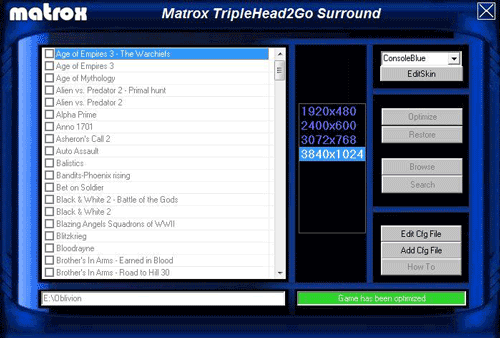
I tried it out in Oblivion, Supreme Commander and TrackMania Nations. In the former it was tremendous, with a GeForce 8800 GTX providing the graphical horsepower. When I went inside a tent I could see the sides appear in my peripheral vision – it was incredibly immersive and moving round the landscape was breathtaking.
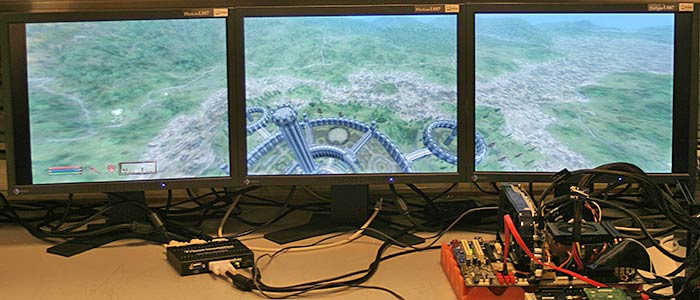
In Trackmania it really helped nail some of the mad tracks, simply because you can see more of the track at once. I got a Gold Medal on second attempts when it would normally have taken me several goes. In Supreme Commander it was great being able to see so much of the battlefield – however I still needed to move up and down to see stuff, which made me lament that relative lack of vertical resolution – just 1,024 pixels. A single 24in display would give me 1,200 pixels vertically, while a 30in screen would provide 1,600.
Discussing this issue with Tim from our sister site www.bit-tech.net we thought that it would be great if we could instead run three 1,600 x 1,200 displays and pivot them. If the TripleHead could then output 3,600 x 1,600, we’d get a screen that’s still a wider resolution than a 30in screen, but with the same vertical resolution. However, it seems that the TripleHead isn’t able to do this as it would involve rotating the image internally which it can’t currently do. However, Matrox said it was working on this and would hope to make it possible in a future product.
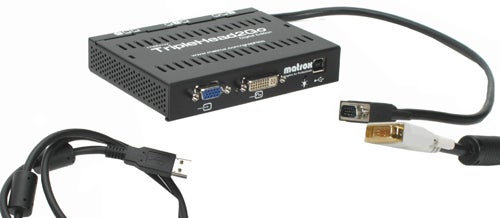
For now then you have to decide between the superwide, and the not quite as high, Triple Head2Go and the very wide but higher vertical resolution you’d get from a 30in display. What might help you decide is that if you choose inexpensive screens you could pick three up of them and the TripleHead for around £500, a lot less than the cost of a single 30in. It really depends if you’re favourite title is on that compatibility list. I’ve recently gone back to playing Oblivion, when I get the chance, and I’d take the three screens any day of the week.
Matrox should be congratulated on the TripleHead2Go Digital Edition. It improves on the analogue version in several key ways, adding DVI for a sharper image, more convenient USB power, and Bezel Management to really improve realism in games. The caveat is that not every title will be supported, though the list is constantly updated. If you’re not interested in games, the TripleHead2Go Digital still offers much if you want to maximise your desktop area for design work, for programming work or if you just want to be flash!
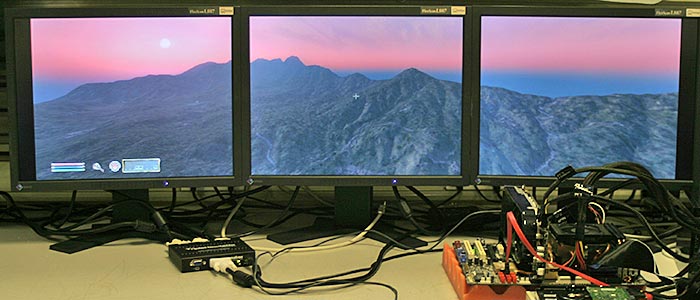
The TripleHead2Go Digital Edition gets an award then by dint of being a clever way to give you more, in Windows and in games. It deserves an award for that and the only reason it gets an ‘8’ and not a ‘9’, is because it won’t be the right choice for everybody, say those who would want to watch movies on their PC and reasonably, would prefer to do it in widescreen, or for those whose favourite games aren’t supported. I also felt that it would be even easier to argue its case over a buying a 30in screen if it was just that bit cheaper – you could keep the cost down, or spend a bit more on better quality screens.
”’Verdict”’
A clever idea that is an appreciable upgrade over the analogue version. If you want to spread out your work across three screens, it’s ideal, especially now you can keep the image digital all the way. And if your favourite game is supported you’ll get an even more immersive experience than on a 30in screen.
Trusted Score
Score in detail
-
Value 8
-
Features 9

